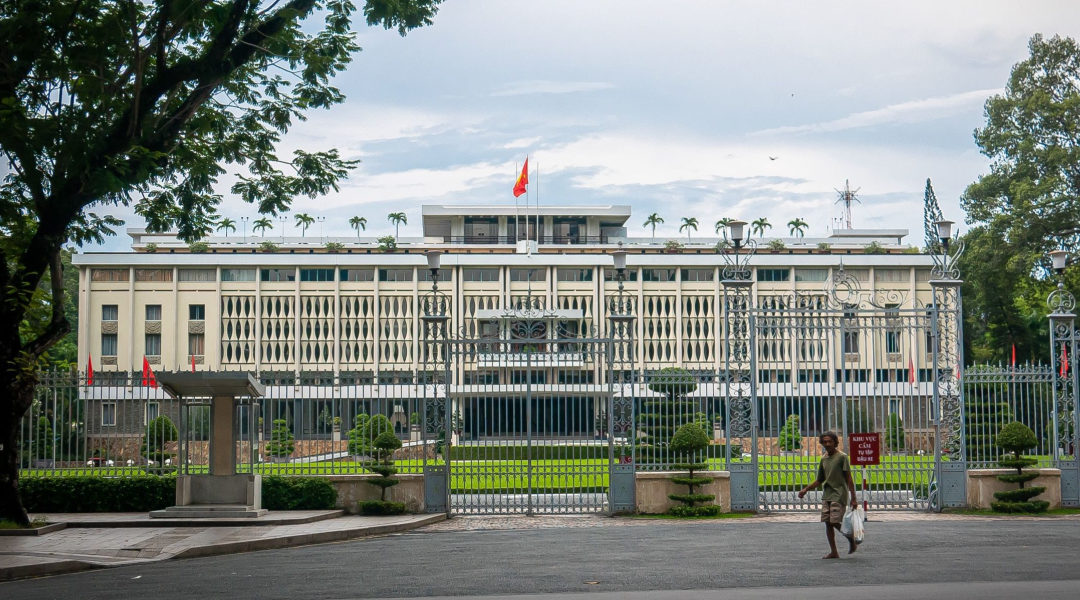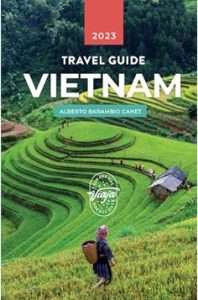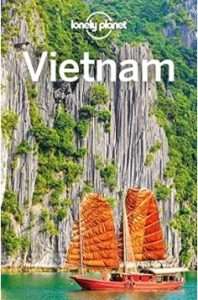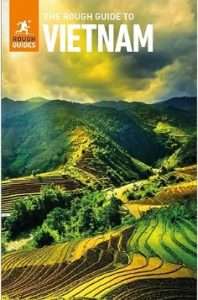This is the second in a series about the most popular tourist sites in Ho Chi Minh City. This one looks at the imposing Reunification Palace, which sits on manicured grounds in the heart of Ho Chi Minh City’s District 1.
After reviewing my series of self-guided walking tours around Ho Chi Minh City, I realized that visitors who don’t like to engage a tour guide need more info about the major sites to make their visit more rewarding. So here’s number 2.
Number 1 – Saigon Notre Dame Cathedral
Number 3 – Saigon Opera House
Number 4 – War Remnants Museum
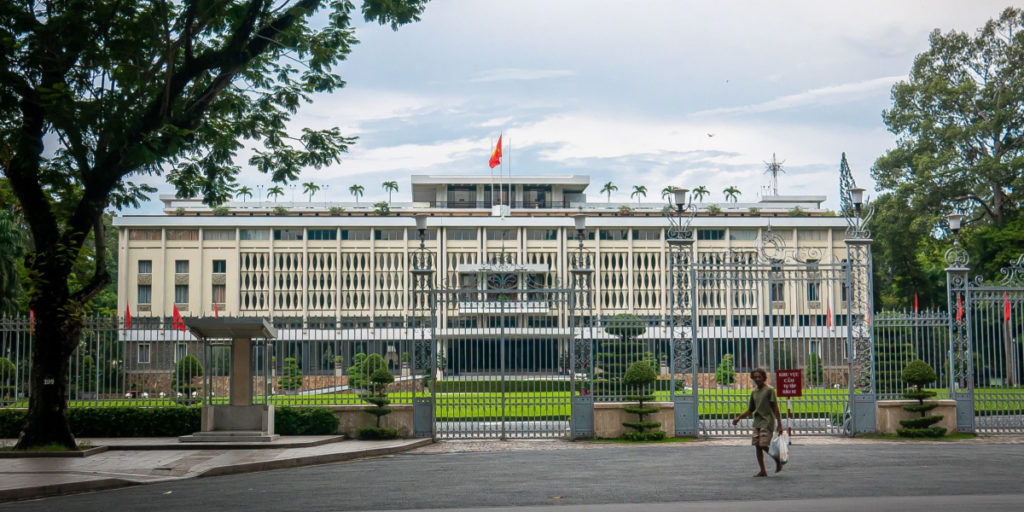
The 2nd in a series about the most popular tourist sites in Saigon - the imposing Reunification Palace in the heart of Ho Chi Minh City's District 1.
Reunification Palace’s most famous moment.
Those of you around at the end of the Vietnam War may have vivid memories of when a North Vietnamese army tank crashed through the ornate gates of Reunification Palace on April 30, 1975. A grand gesture that effectively signaled the end of the bitter struggle to reunite the country.
Reunification Palace is one of the most popular attractions in Ho Chi Minh City.
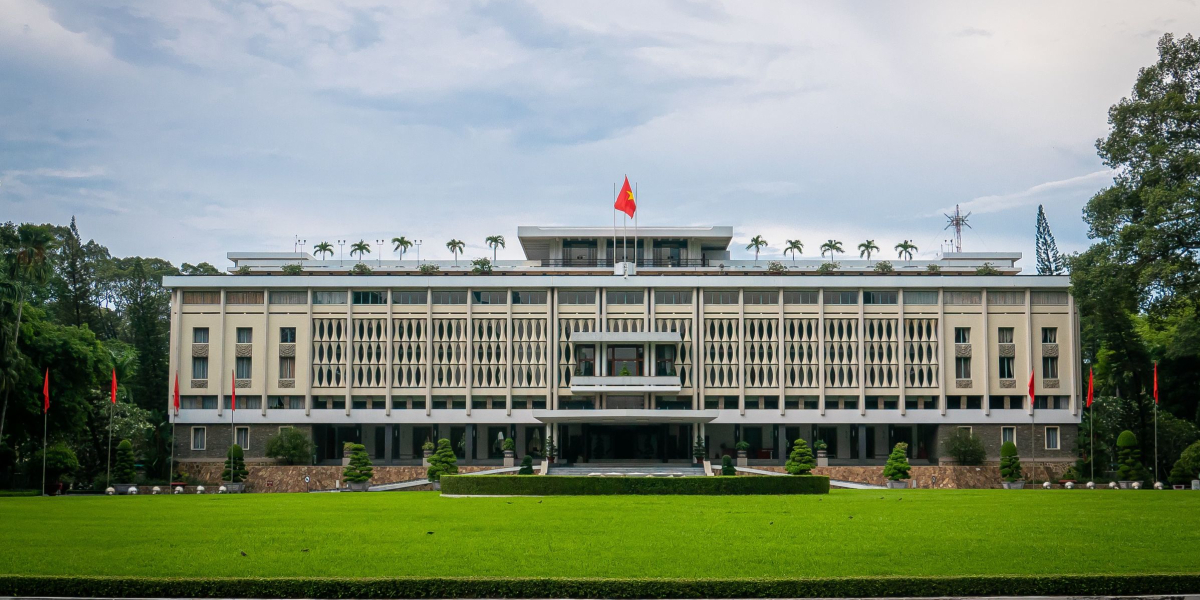
Reunification Palace looks over a huge oval grassed area.
The Vietnam War
The Vietnam War (or American War to many Vietnamese) was a prolonged military conflict between North and South Vietnam and their respective allies, the Soviet Union and the United States, lasting from 1954 to 1975.
The conflict began after the Việt Minh, a communist-led nationalist movement led by Ho Chi Minh, defeated the French army and French Colonial rule. The country was then divided into two parts. The communist North Vietnam aligned with the Soviet Union and China, and South Vietnam was later supported by the US and other Western allies who wanted to halt what they saw as an Indochina invasion by communists.
The resulting conflict was brutal and led to the death of millions of people, many of them civilians.
The bottom line is the US and its allies, with all their superior firepower, totally underestimated the will and the tenacity of the Vietnamese people, revolutionary forces, and North Vietnamese army.
One of the key turning points of the war was the TET offensive of 1968, a coordinated series of attacks by the Northern forces across Southern Vietnam. You can read a little more about that in our blog about a Pho shop that was integral to this battle.
In 1973, after years of negotiations, the Paris Peace Accords were signed, which called for a ceasefire, the withdrawal of U.S. forces, the release of prisoners of war, and the recognition of the sovereignty of both Vietnams. Unfortunately, neither side complied with the terms and continued to fight.
The second turning point came in 1974 when the U.S. Congress cut off military aid to South Vietnam in 1974. It left the South Vietnamese army vulnerable to the North Vietnamese offensive.
Not long later, in 1975, the North Vietnamese army captured Saigon, the capital of South Vietnam, and reunified the country under communist rule.
The Vietnam War was officially over, but its legacy and impact would last for decades.

Telecommunications equipment in the basement of Reunification Palace. Credit: Diego Delso, https://commons.wikimedia.org/w/index.php?curid=30078210
The History of Reunification Palace (AKA Independence Palace)
Reunification Palace is one of the most recognizable structures in Ho Chi Minh City but is a relatively new arrival to Ho Chi Minh City, or Saigon, as it was known.
The original building on this site was Noordam Palace, which was built in 1873 by the French colonialists as the residence of the Governor-General of French Indochina.
In 1962, a bombing raid by two rebellious South Vietnamese pilots who clearly didn’t approve of the President at the time, Ngô Đình Diệm, caused significant damage. Rather than have it repaired, President Diem ordered it leveled and a new one built in its place.
The construction started in 1962 and was completed in October 1966.
Unfortunately for President Diem, he never got to move in, as he was assassinated in 1963 by some of his own staff.
Instead, General Nguyễn Văn Thiệu, Chairman of the National Leadership Committee, and head of a military junta at the time moved in. Not long after, he got a promotion to the top spot.
President Nguyen Van Thieu hung around until April 1975, when the North Vietnamese Forces were clearly taking control of the South. He fled the country a few days before the North took full control of Saigon.
After all the treaty negotiations were completed between the two sides in November 1975, the Provisional Revolutionary Government promptly changed the name from Independence Palace to Reunification Hall.
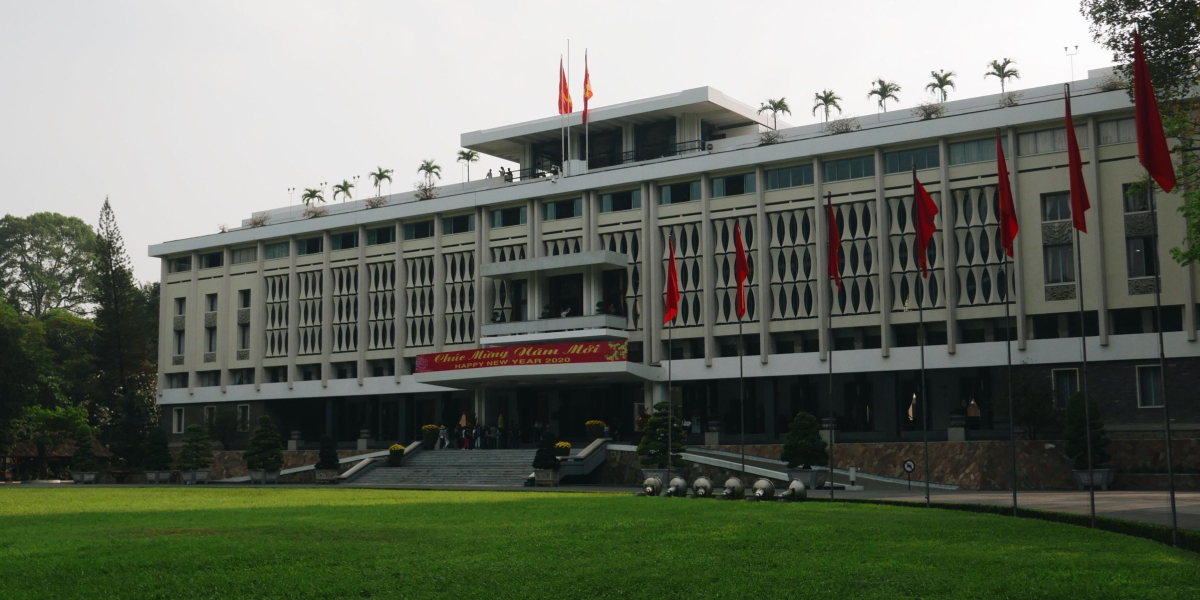
View of Reunification Palace from inside the grounds.
Independence Palace Architecture
The new building was designed by Vietnamese architect Ngô Viết Thụ, one of Vietnam’s most decorated creatives. Amongst other awards, he received the Prix de Rome in Architecture in 1955.
It’s not a particularly beautiful building, but it is striking and is easily recognizable as a key landmark in Ho Chi Minh City. The interior decor and furnishings aren’t for folks like us either. Think lots of velvet and gold leaf.
The building combines elements of Vietnamese culture with the ’60s style at the time.
Looking deeper into the design reveals an incredible attention to detail, symbolism, and historical significance. The palace layout forms the Chinese character for “fortunate” or “auspicious.” And there are many other examples of this symbolism throughout the structure. I found the best explanation on the Official Government Website. They do it much better than I ever could.
As you enter the huge and ornate main gates, you’ll first see an enormous oval lawn with a more than 100 m wide diameter. The wide facade, covered in stone latticework, is meant to resemble bamboo sections, similar to those found on palaces in the ancient capital of Hue.
The palace has 95 rooms in total spread across 3 floors, 2 mezzanines, a terrace, a ground floor, and a basement. Each floor has a different function and style. Only a few are still used for official business.
- The ground floor is arranged with a cabinet room and meeting rooms, for important political and diplomatic events.
- The first floor has a grand reception hall and a large dining room, where the president welcomed and entertained guests.
- The second floor has the workplace of the president, his private rooms, and a credential submission room.
- The top floor has a movie room, an ‘interestingly’ decorated card-playing room, a ‘night club’, and a rooftop terrace with a helipad.
- The basement has a war command room, a telecommunications centre, and a tunnel system.
The complex, which spans a full city block, is now used as a museum and is open to the public.
Visitors may also wander around most of the substantial grounds containing large shady trees and extensive grassed areas. Here, you’ll find a fighter plane that bombed the Palace on April 8th, 1975, and the tank that smashed through the gates on 30 April 1975.

One of the 95 rooms in Reunification Palace. Credit: Clay Gilliland https://www.flickr.com/photos/26781577@N07/12110929286
Historical Artifacts
The whole complex is filled with unique historical artifacts, and the signage is in both Vietnamese and English.
You can visit most areas of the building, including the downstairs meeting rooms, upstairs reception rooms, and the President’s personal chambers. The second floor features an “interestingly” decorated card room, a cinema, and a rooftop nightclub complete with a helipad.
What was the helipad at Reunification Palace Used For?
The president of South Vietnam and his guests used the helipad for transportation and evacuation purposes. The helipad played an integral part in the history of Independence Palace and was the site of several historical events during the Vietnam War.
On February 27, 1962, when the two dissident pilots of the South Vietnamese Air Force bombed the palace in an attempt to assassinate the president, they missed the main building but damaged the left wing and the guest house. The President and his family used the helipad to escape unharmed and flee to a nearby military base.
On April 8, 1975, a group of South Vietnamese commandos raided the palace and captured several high-ranking officials, including the vice president, the prime minister, and the defense minister. They then seized the helipad and tried to escape. Unfortunately for them, they didn’t make it and were captured and forced to surrender.
On April 30, 1975, the last helicopter to leave the palace took off from the helipad. Onboard were the remaining staff from the palace and some foreign journalists. The helicopter was one of the last to leave Saigon before the North Vietnamese forces took full control of the city.
In the basement, you can see “the war room,” which displays maps, charts, and the telecommunications hub with lots of ancient communications equipment. There is also a room showing videos about the Palace in 5 languages. The national anthem is played at the end of the tape, and you are expected to stand up as a sign of respect.
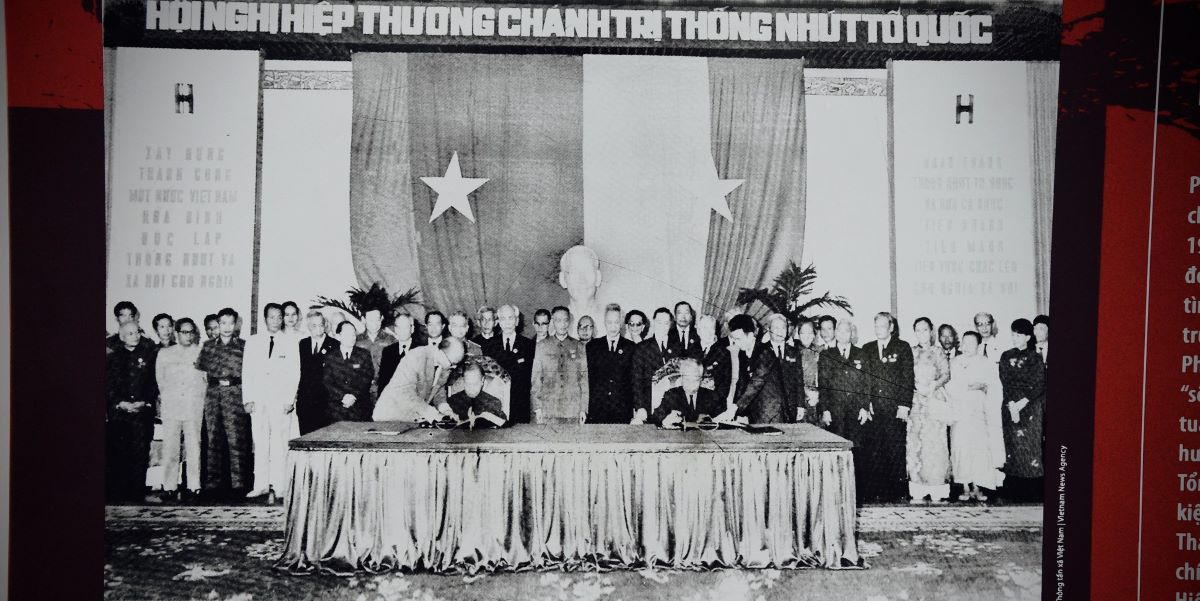
One of the many historic pictures on display in Reunification Palace. Credit: Kent MacElwee https://www.flickr.com/photos/kmacelwee/32237535825
Independence Palace Tanks
As you walk into the main entrance of the Palace, you’ll see a couple of Russian-made T-54 tanks on the lawn, close by where the North Vietnamese Army crashed through the gates on April 30, 1975.
These historic relics are surrounded by fences and have signs explaining their significance. You can take photos of the tanks and learn more about the history of the palace and the war.
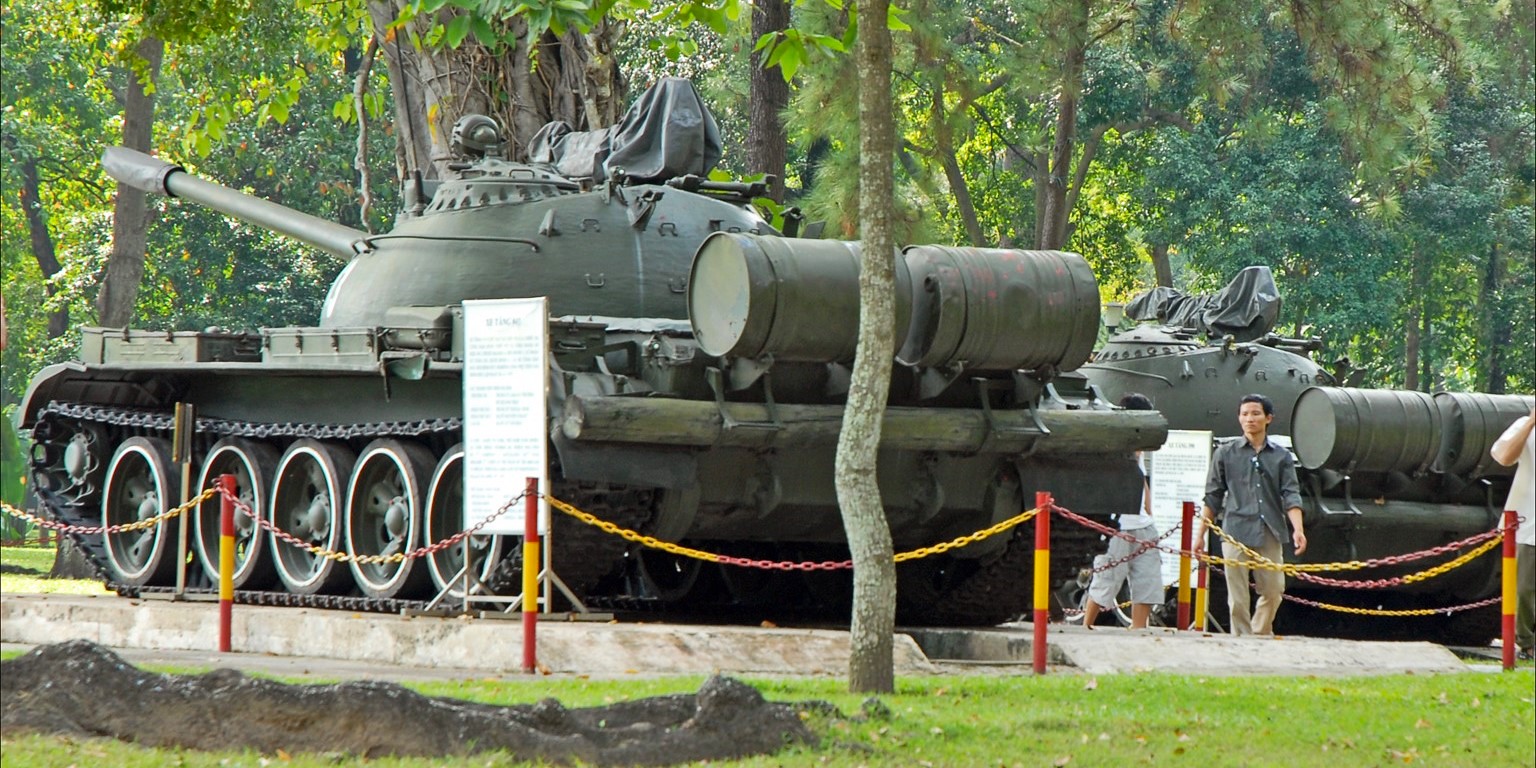
A tank crashing through the gates of the Palace signalled the end of the Vietnam War.
Access To Independence Palace.
Where Can You Find Independence Palace?
Reunification Palace stands grandly at 135 Nam Ky Khoi Nghia, District 1, in downtown Ho Chi Minh City. Surrounded by lush green gardens, it takes up a whole city block.
Standing at the gates at the t-junction where Le Duan Street and Nam Ky Khoi Nha meet and looking straight ahead through the shady 30/4 Park, you may glimpse the red bricks and soaring bell towers of Saigon Notre Dame Cathedral. (Pro Tip: 30/4 Park is named for 30th April 1975, when the tanks crashed through the gate.)
Adjacent to that, you’ll find the beautiful French Colonial Saigon Central Post Office, Book Street, and Diamond Plaza, one of Ho Chi Minh City’s most popular shopping malls.
Walk 5 minutes to the north, across Nguyen Thi Minh Khai Street to Vo Van Tan Street, and you’ll find the sobering War Remnants Museum. Walk 5 minutes south and find the stunning People’s Committee Building, Saigon Opera House, and Nguyen Hue Walking Street in the city center.
A short walk East, along Nguyen Du Street, you’ll find the Ho Chi Minh City Museum, another worthwhile attraction on your visit to Saigon.
Ben Thanh Market is about a 9-minute walk if you exit via the back gate.
The central location of Reunification Palace makes it a perfect stop-off point for any tour of central Saigon.
I’ve put together a FREE self-guided Walking Tour of Ho Chi Minh City that visits this and all the other main sites in this area for your convenience.
You can find the official website for the Palace HERE.
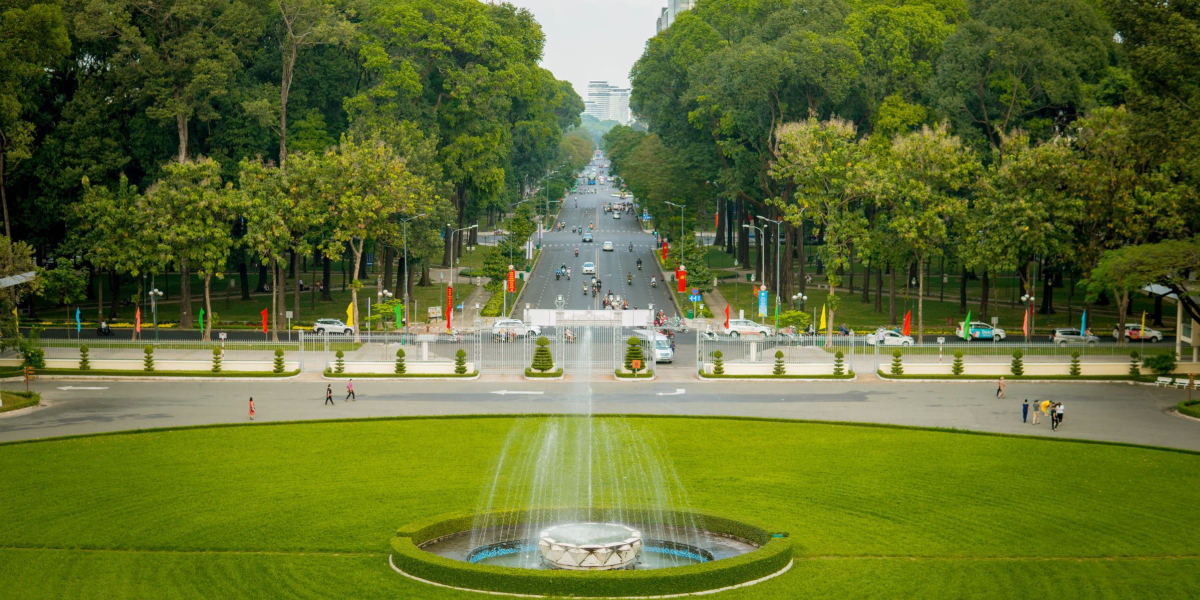
View from the Palace looking down Le Duan Street
What are the Opening Hours of Reunification Palace?
Reunification Palace is open all week from 8.30 AM to 4:30 PM. They stop selling tickets at 3:30 PM.
What is the Entrance Fee for Reunification Palace?
Yes, you will need to pay to enter Reunification Palace.
Entrance tickets are VND 40,000 (about $1.60) for adults. Guided tours in English are available.
There is a special exhibition on at the moment. “From Norodom Palace to Independence Palace 1868-1966” explores the century-long history of the building that once served as the seat of the French colonial government in Cochinchina. Entry to this exhibit plus the palace is VND 65 000 for adults.
Is there a dress code for Reunification Palace?
While I don’t think there’s a strict dress code for entry to Reunification Palace, it is a formal government building so please show respect by not wearing revealing tops, skirts, or shorts.
Are there any other rules for entry to Reunification Palace?
You can only bring small bags inside the structure. So you’ll need to leave any Big luggage at the security point.
Don’t walk on the grass or touch displays around the palace.
Don’t bring food, drinks, or animals into the monument.
Always follow the instructions of the guards and signs during the visit. If you hear someone shouting at you, you’re probably doing something wrong.
The palace is occasionally closed to the public during VIP visits or other special events.
Is it easy to book a Tour Guide for Reunification Palace?
Yes. You can usually pick up a guide at the entrance to the palace, and they now have audio guides if you’d prefer to go at your own pace.

The Palace has clean lines and a clever design to let in lots of light.
What’s next after your visit to Saigon’s Reunification Palace?
So there you go, everything you need to know about the Reunification Palace in Ho Chi Minh City.
But I’m sure that’s not the only tourist destination you want to visit while you’re here.
So, take a look at my free, self-guided walking tours around town.
Free Walking Tour 1, takes in all the popular sites around District 1, including Saigon’s Notre Dame Cathedral.
Walking Tour 2 goes a little further afield and visits some less visited but still fascinating sites in central Saigon.
Under both walking tours, you’ll find suggestions for many other activities and excursions around Saigon. These include day tours to Cu Chi Tunnels and Vung Tau, perfect for history buffs who want to know more about the Vietnam War.
I’ve added some links to resources for your trip to Vietnam below and a heap more over on our Vietnam Page which lists a heap of resources and information. And also the Ho Chi Minh City Visitor’s Information Page.
And finally, if you want to stay in the loop, sign up for the TRAVEL BUG TIMES and travel better for less.
Each issue contains:
-
- travel tips from experts,
- lessons from the road,
- great deals, and
- carefully curated products and services.
Vietnam Travel Guide
Traveling to Vietnam but don’t know where to start? This travel guide has everything you need to start planning your adventure in this amazing country.
Lonely Planet Vietnam
Lonely Planet’s Vietnam is your passport to the most relevant, up-to-date advice on what to see and skip, and what hidden discoveries await you.
Rough Guide Vietnam
A practical travel guide to Vietnam featuring detailed travel tips and points of interest, lists of all iconic must-see sights, and off-the-beaten-track treasures.
Heading to Vietnam Soon?
Check out our Travel Resource pages before you start planning and booking. Everything you need in one place to save you money and travel better.
And more…
Book Your Flight
Use WayAway to find cheap flights. They are our favorite search engine because they search websites and airlines around the globe. (Including the tiny budget ones many other search engines ignore.)
Book Your Accommodation
To find the best deals and book most of our accommodation (when we’re not housesitting,) we use:
-
- WayAway
- Booking.com, and
- Agoda
If you are more into Hostels, then Hostelword is the biggest platform for those.
Don’t Forget Travel Insurance
Travel insurance will protect you if anything goes wrong before or during your trip. We never travel without it and have needed it many times. We’ve used a few companies with excellent results over the years.
Consider:
- Covermore (Australians)
- Safety Wing (All nationalities. Great for long-term travelers and Digital Nomads.)
- World Nomads (All nationalities. Great for long-term travelers and Digital Nomads.)
- Visitors Coverage (to see a more extensive range of available plans from different providers, including policies for over 60’s.)

